Sponsored Content
Leveraging Wazuh for CIA triad compliance
The CIA triad is a security model that provides principles for protecting IT assets such as hardware, software, firmware, and information from various threats. The abbreviation CIA stands for Confidentiality, Integrity, and Availability, representing the three fundamental principles in cybersecurity. Implementing these principles enables security professionals to analyze the root causes of system malfunctions or cyberattacks and develop strategies to remediate them effectively.
The CIA triad is the core to designing information security policies and frameworks. Regulatory compliance standards, such as NIST, PCI DSS, and GDPR, have defined these principles for managing information security. An effective security system or platform satisfies all three components of the CIA triad.
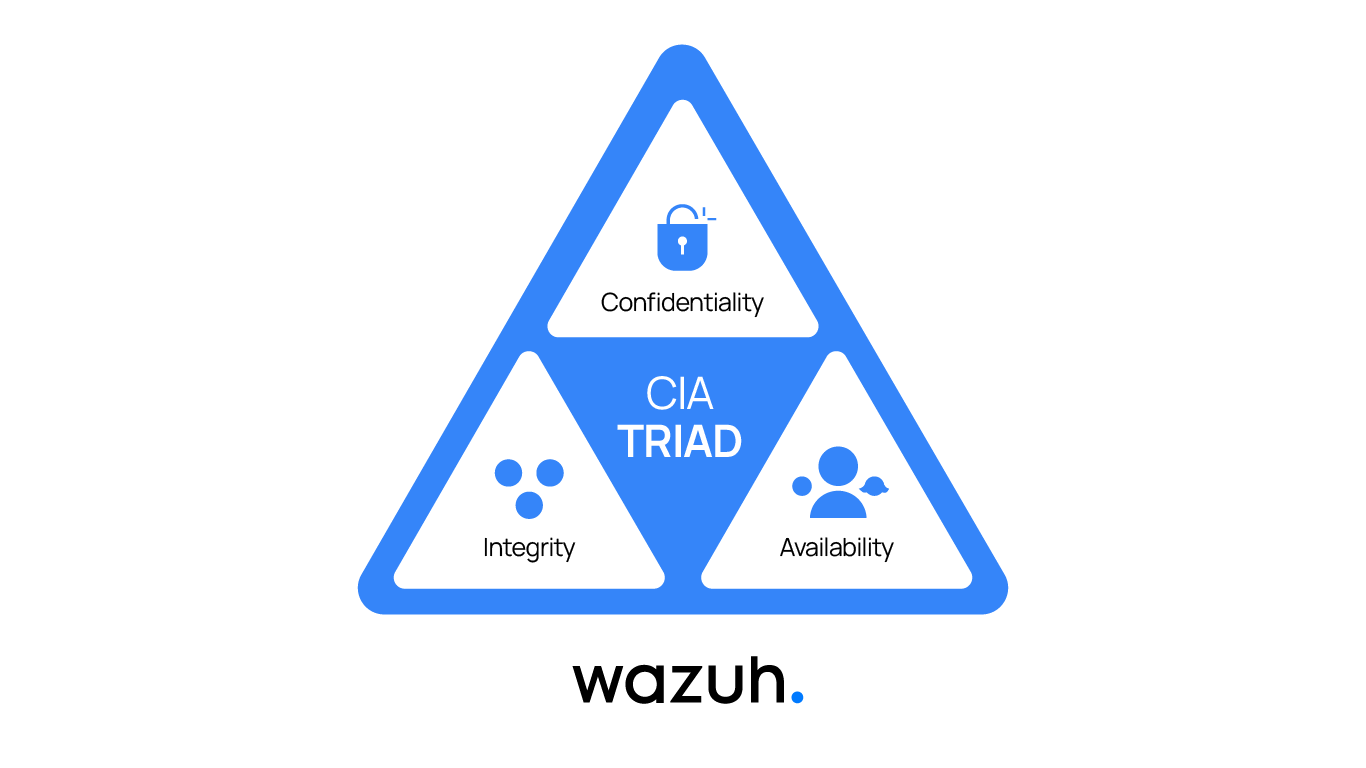
Information security has grown and evolved significantly in recent years, driven by technological advancements and the expanding complexity of digital ecosystems. This evolution has led to the emergence of increasingly sophisticated security threats, including advanced persistent threats, ransomware, complex phishing schemes, physical theft, and natural disasters. Therefore, organizations must adhere to the CIA triad to protect information and mitigate risk for business continuity.
Principles of the CIA triad
The CIA triad consists of three core principles that are fundamental to information security.
Confidentiality
This principle ensures that information is accessible only to those authorized to have access. Organizations need security measures to ensure confidentiality that protects sensitive information against unauthorized access. These measures include access control, data encryption, and implementing multi-factor authentication protocols.
Integrity
This principle ensures data is authentic, reliable, and unchanged. It covers data in storage, transit, and in-use. The integrity of data is protected by error-checking and validation methods, such as checksums or digital signatures, to confirm that data has not been tampered with during transmission or storage.
Availability
This principle ensures that information is consistently accessible to authorized users when needed. It means protecting systems and applications against attacks that can cause downtime, such as Denial of Service (DoS) attacks. Additionally, it ensures reliable hardware and network infrastructure with appropriate failover and redundancy measures.
Benefits of the CIA triad
The CIA triad provides several benefits to organizations in protecting their assets. Below are some key benefits of implementing the CIA triad:
- Data security and privacy: Implementing the principles of the CIA triad helps to protect data from sophisticated attacks and unauthorized access attempts.
- Complying with regulatory compliance standards: Regulatory compliance standards and frameworks, such as GDPR, HIPAA, and PCI DSS, require the implementation of confidentiality, integrity, and availability measures to secure data.
- Risk management: The CIA triad helps in identifying and categorizing cyber threats and vulnerabilities effectively. Additionally, it helps in developing mitigation strategies to address specific threats, such as data breaches, unauthorized modifications, and service disruptions.
- Improved incidence response: Implementing the CIA triad helps in developing incident response plans that are focused on specific security incidents. This ensures efficient and effective response strategies protecting critical assets.
- Trust and reputation: The principles of the CIA triad can enhance customer confidence and trust, demonstrating a commitment to protecting their data. Protecting customers' data from threats keeps the reputation of the organization.
Implementing the security principles of the CIA triad helps organizations build robust defense strategies against cyber threats.
How Wazuh helps organizations align with the CIA triad
Wazuh is a free and open source security monitoring platform that protects IT assets against threats that target the core pillars of cybersecurity. It is a unified XDR and SIEM that helps you monitor and promptly respond to security incidents across workloads in the cloud and on-premises environments. Wazuh helps organizations align with the CIA triad to comply with various regulatory requirements and enhance cybersecurity defenses.
Confidentiality
Wazuh maintains data confidentiality by monitoring unauthorized access and detecting suspicious activities.
Access control monitoring
Wazuh analyzes log data generated by operating systems, applications, and network devices. It collects and aggregates logs to detect anomalies, user activities, unauthorized access attempts, changes in user privileges, and other potential threats. The Wazuh analysis engine utilizes decoders to parse the logs into useful fields and match them against out-of-the-box or custom rules.
For example, the SSH login attempt log below triggers a default Wazuh rule that generates an alert on the Wazuh dashboard.
The Wazuh analysis engine decodes the log into meaningful fields, including the source IP address 192.168.1.24 and the user hacker login attempt as seen in the image below.
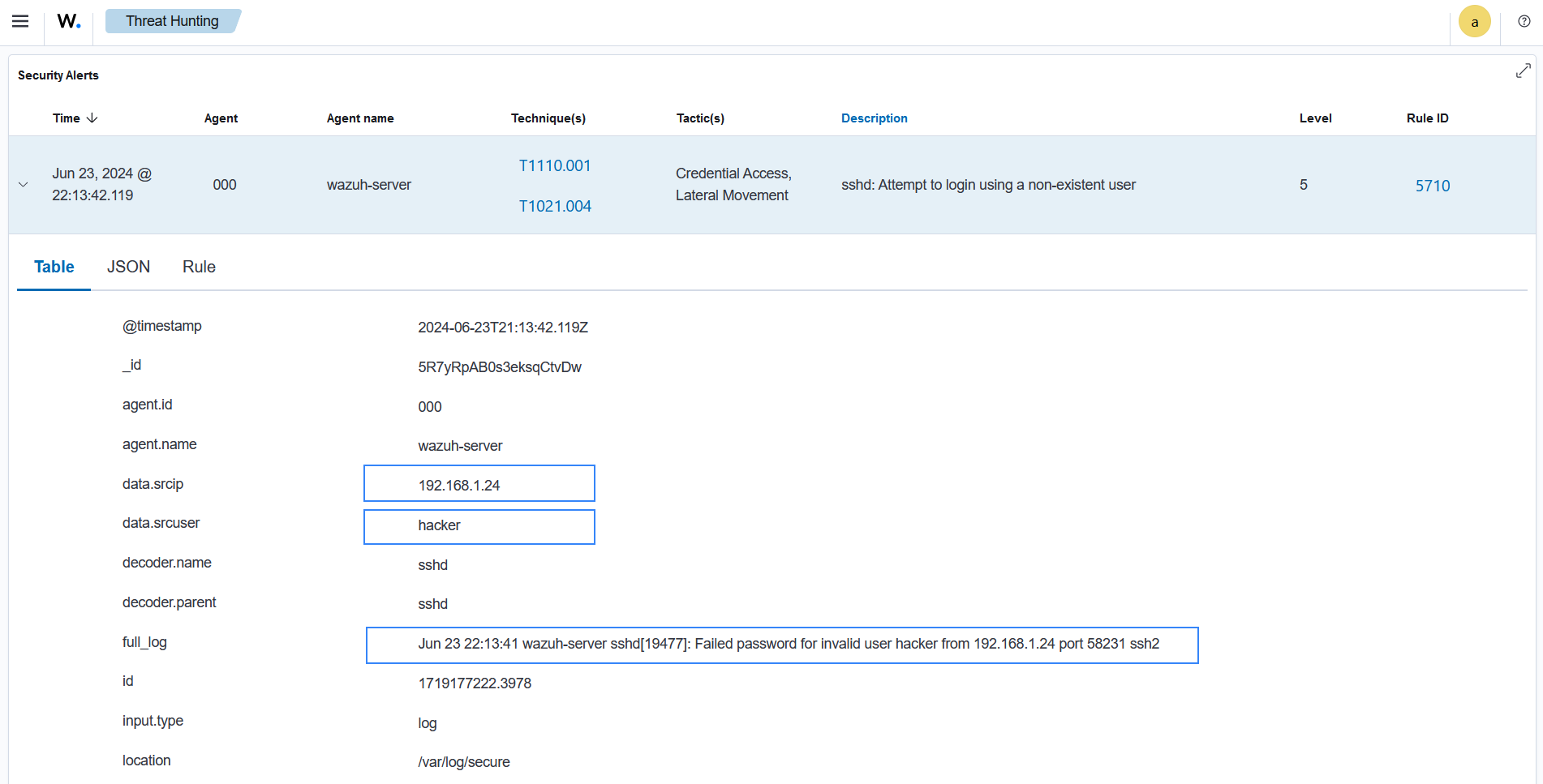
Wazuh triggers an alert of an unauthorized SSH login attempt against the Wazuh server.
Integrity
Wazuh strengthens the integrity of systems and data by monitoring for unauthorized changes and unintentional data tampering with the following methods.
File integrity monitoring
Wazuh employs a File Integrity Monitoring (FIM) capability to monitor specified files, directories, and registry settings, alerting administrators when changes are detected. These changes involve adding, modifying, or deleting system, application, or configuration files and registry settings that maintain the operational and security baseline of endpoints. The default rules 554, 550, and 553 generate alerts when a user or process adds, modifies, and deletes a file from a monitored endpoint.
The /etc/hosts.allow file on a Linux endpoint specifies which IP addresses are permitted to connect to the host. An observed modification to this file might indicate an attack attempt. You can configure the Wazuh FIM module to monitor this file in real-time and generate an alert when the file is altered. For example, if the user smith adds the new IP address 192.168.32.5 in the monitored /etc/hosts.allow file, we get the following alert.
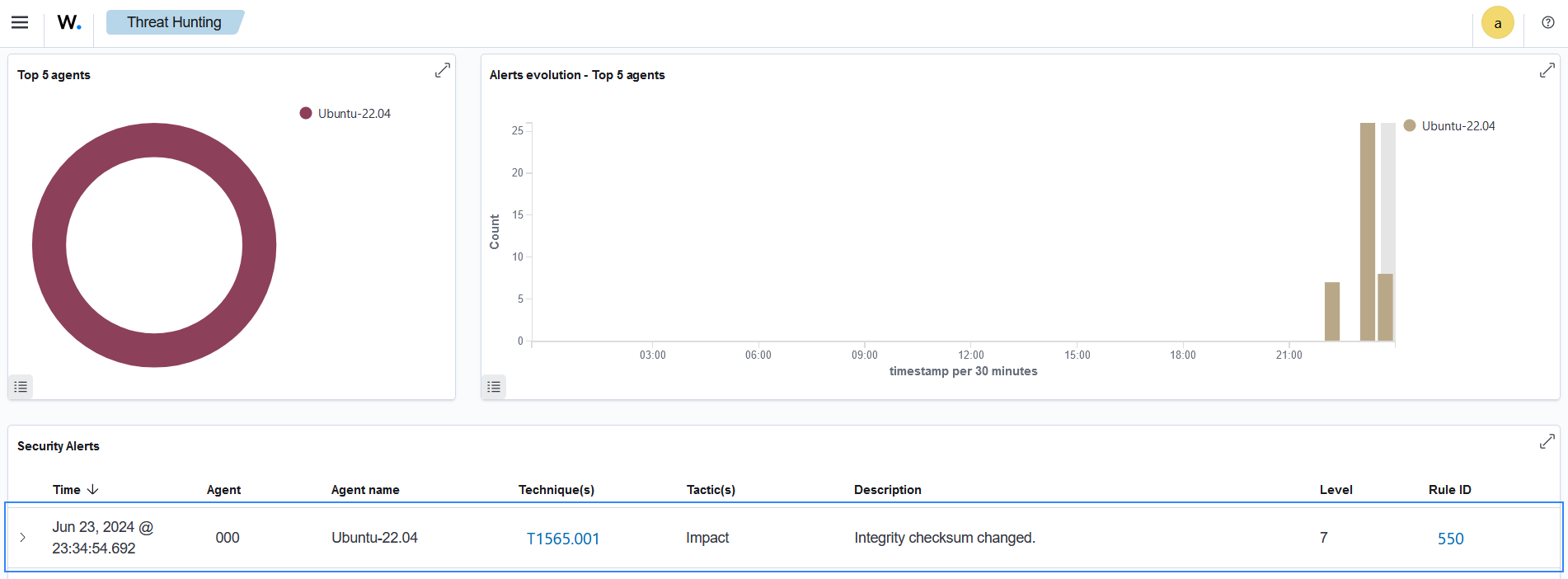
Wazuh file integrity alert of a monitored Ubuntu endpoint.
Expanding the alert, you can see in the alert fields that the user smith added a new IP address 192.168.32.5 to the /etc/hosts.allow file using the nano text editor with root privileges.
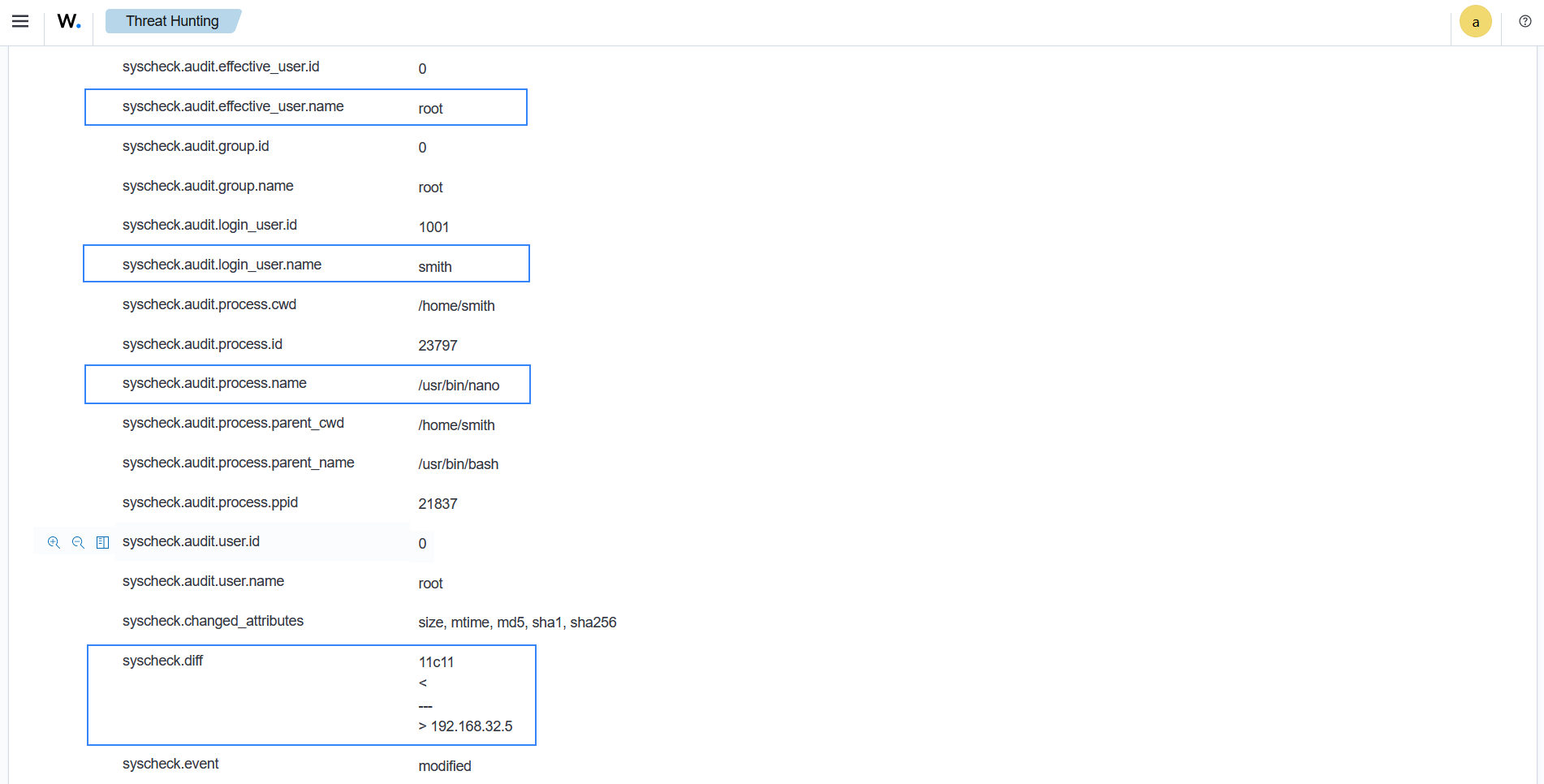
Details of a Wazuh file integrity alert of a monitored Ubuntu endpoint.
Configuration assessment
Configuration assessment is an effective way to identify weaknesses in your endpoints and patch them to reduce your attack surface. Security Configuration Assessment (SCA) is verifying systems conform to a set of predefined rules regarding configuration settings and approved application usage. This process hardens endpoints, reducing their attack surface.
The Wazuh SCA capability allows you to perform configuration assessment by running periodic scans to determine if endpoints conform to security hardening and configuration policies. It provides recommended actions about necessary patches and updates that help protect against exploits that could corrupt data or system states. When a system has been hardened, SCA policies can help to check for deviation from the mandated standards.
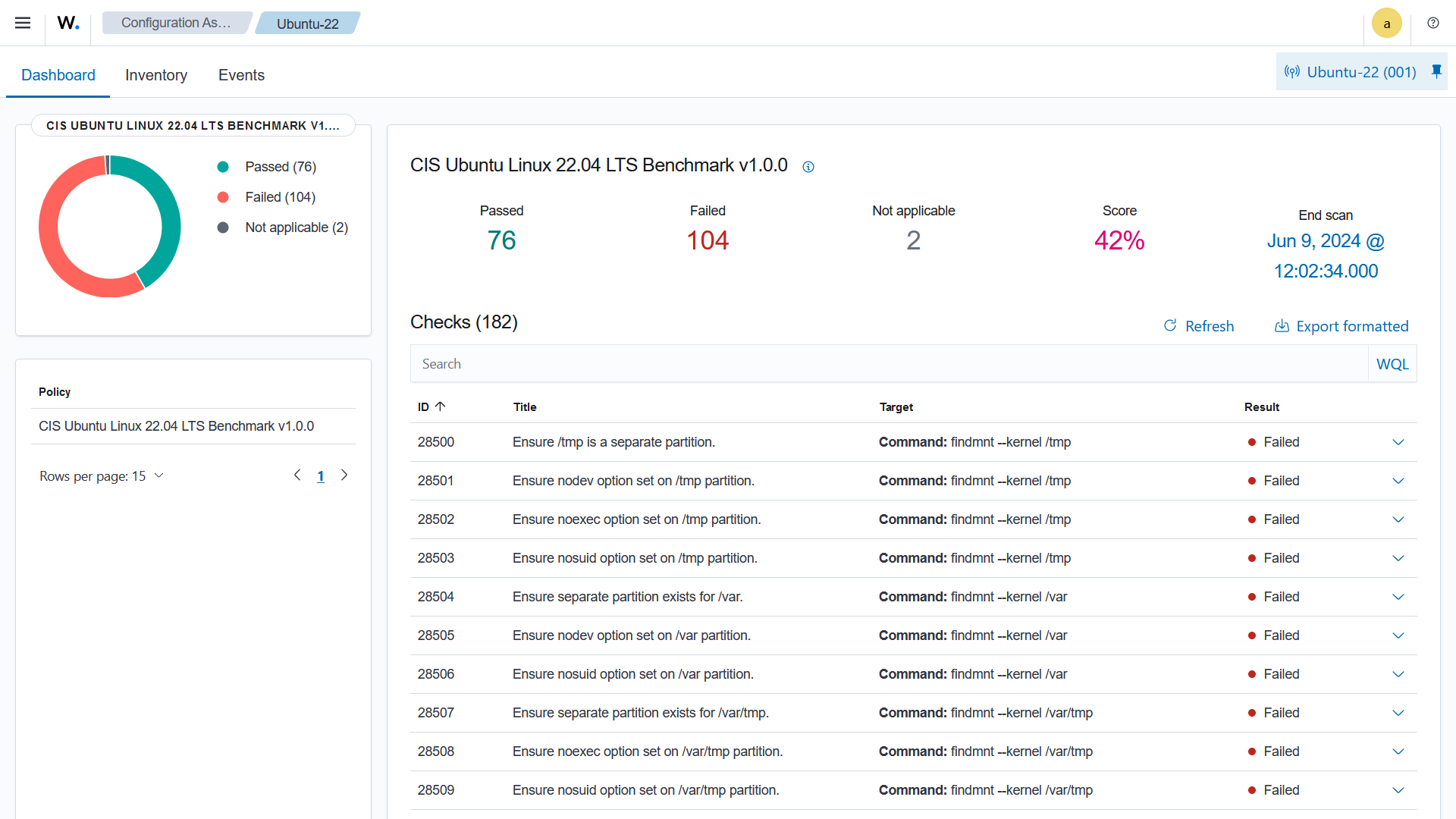
Wazuh SCA scan results of a monitored Ubuntu endpoint.
You can expand each SCA alert to view details about the rationale, description of the SCA check, remediation steps, and more.
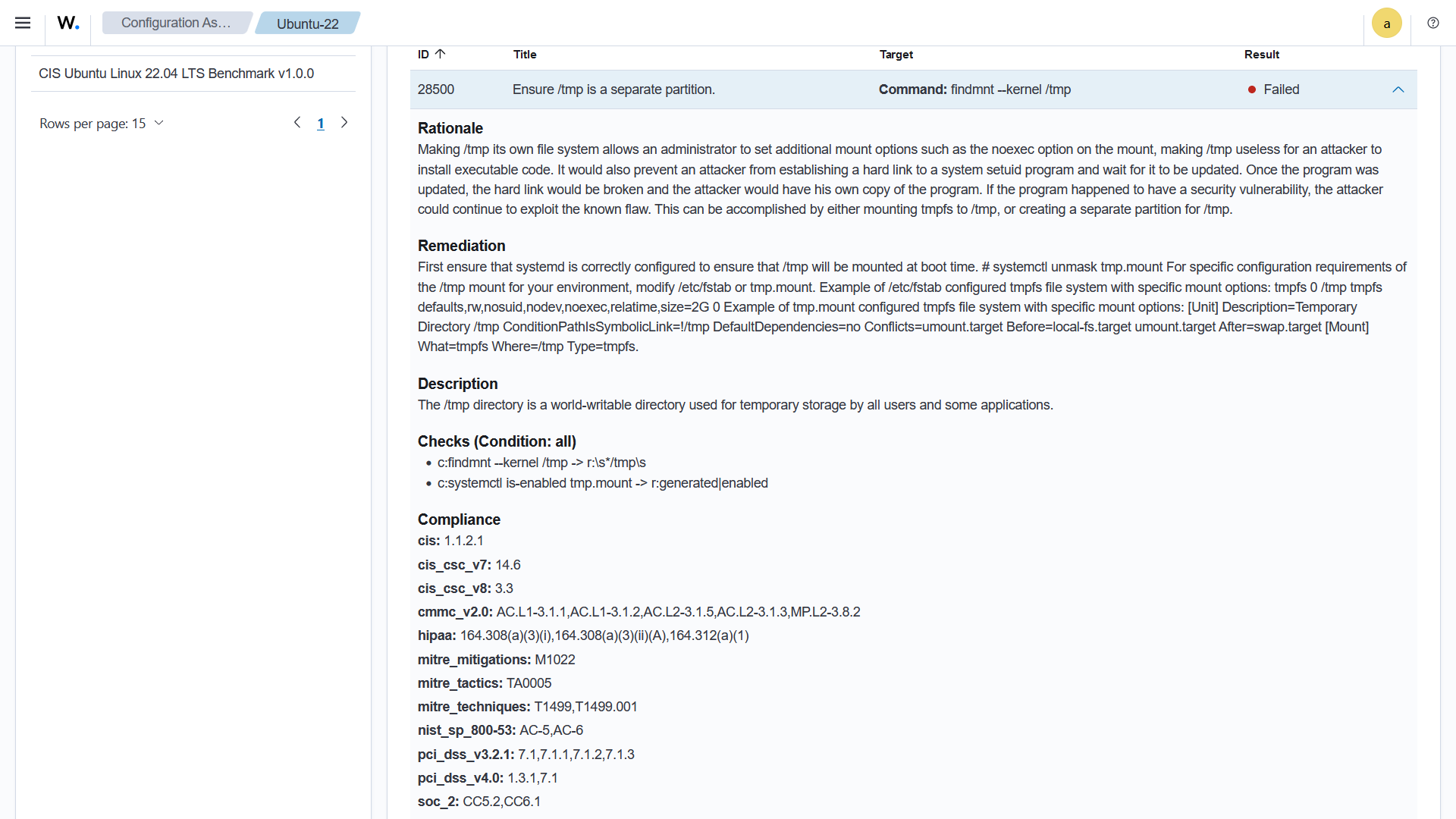
Details of Wazuh SCA scan alert of a monitored Ubuntu endpoint.
System inventory monitoring
System inventory is the process of maintaining detailed information about the hardware, software, and network assets within an IT infrastructure. Keeping an inventory of all assets helps organizations maximize visibility into their environment, meet regulatory compliance standards, and respond to incidents.
The Wazuh system inventory capability helps to collect system data that includes hardware and operating system information, installed software, network interfaces, ports, and running processes. You can configure it to track and alert on unauthorized modifications to system configurations including detecting unknown ports, new network interfaces, and others. This ensures that data remains accurate and unaltered.
You can view the system inventory of each monitored endpoint by selecting an agent and navigating to Inventory data from your Wazuh dashboard. The inventory data for a monitored Windows 11 endpoint is shown below.
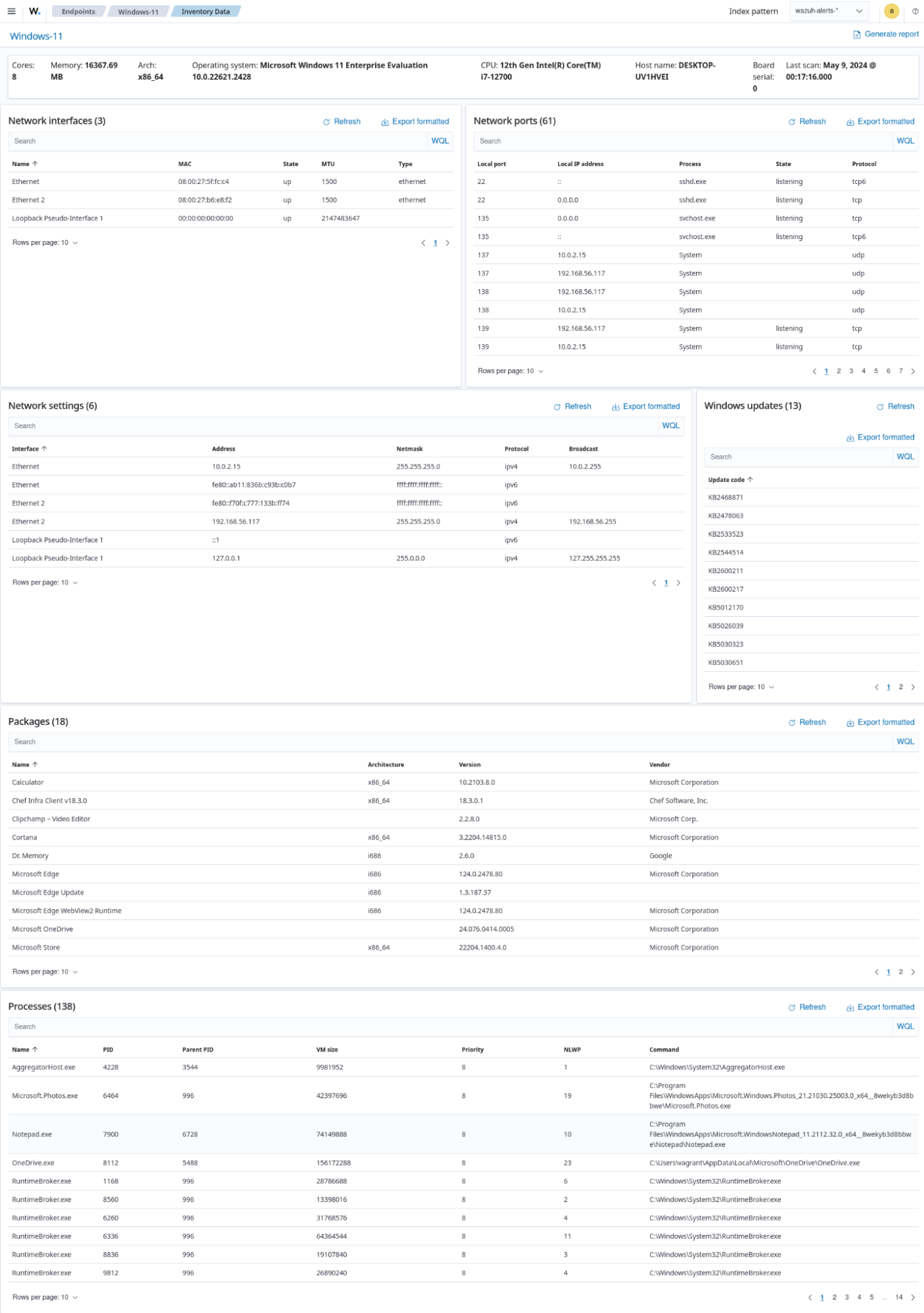
Wazuh dashboard showing system inventory data of a Windows 11 endpoint.
Availability
Resource monitoring
Unusual resource consumption, such as excessive CPU usage, memory utilization, or high network activity, can indicate system failure or malicious activities. Wazuh offers a command monitoring capability you can configure to provide a comprehensive view of system resources such as CPU, memory, disk, and network. This capability allows you to monitor, analyze, and visualize endpoint metrics and their impact on system performance.
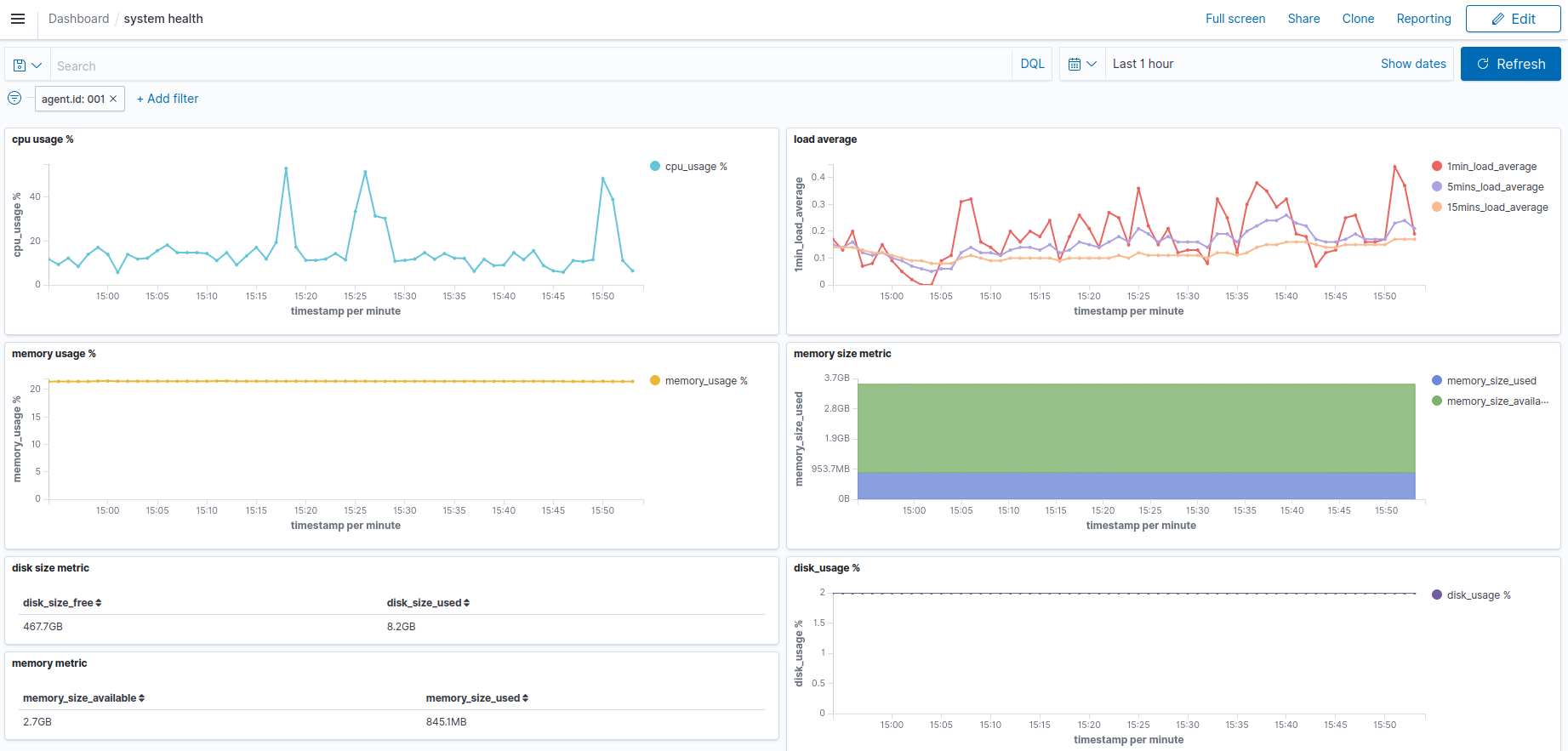
Wazuh dashboard showing resource consumption on a Linux endpoint.
Additionally, many organizations have adopted Docker technology to quickly package software in standardized units for development, shipment, and deployment. Increased Docker usage provides adversaries with an additional asset to target. Wazuh can continuously monitor Docker containers to gain complete visibility into their resource usage and health status. You can see alerts generated on the Wazuh dashboard when an NGINX container exceeds specified thresholds and becomes unhealthy. Visit the Docker container security monitoring with Wazuh blog post for more information.
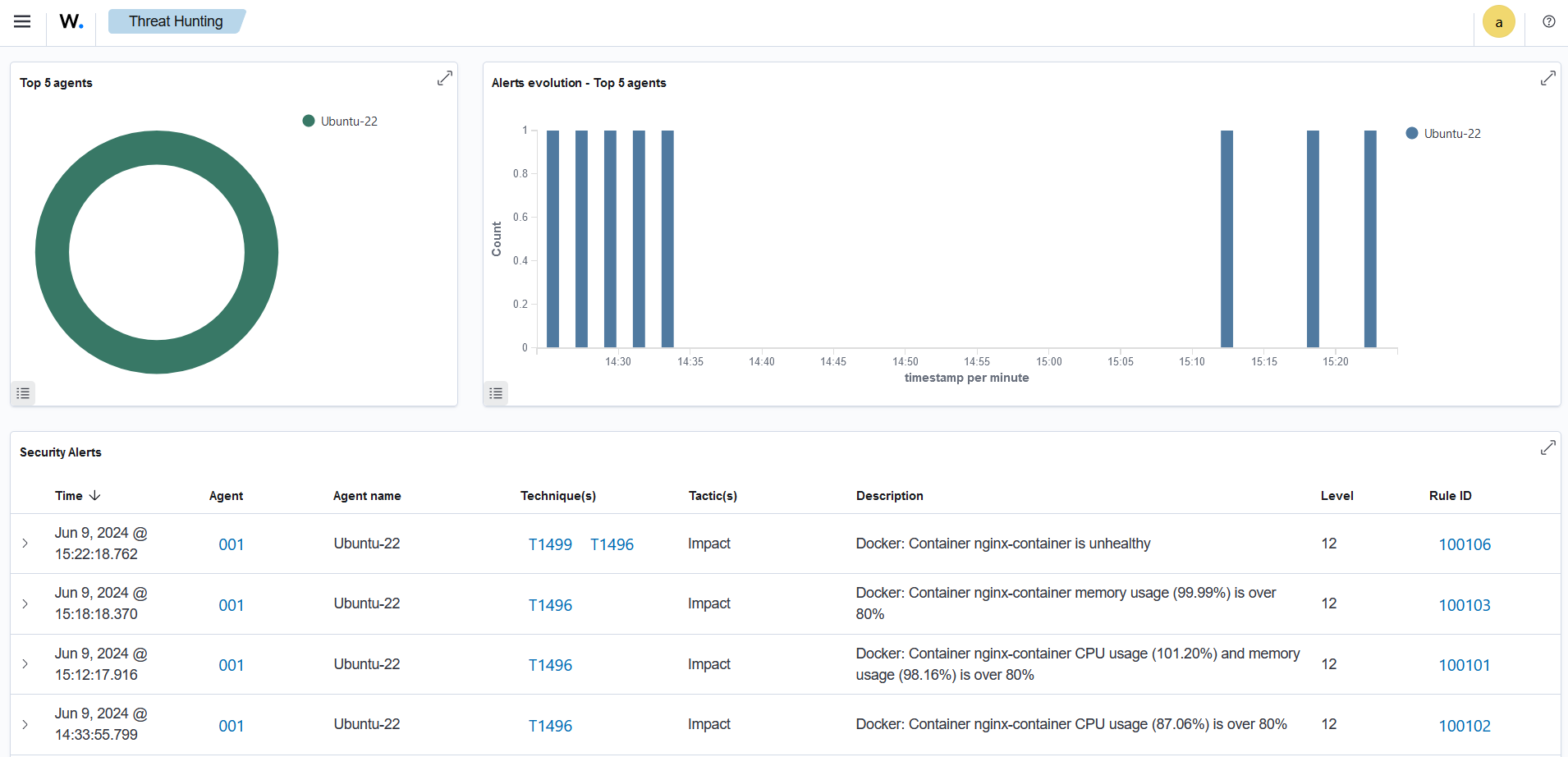
Wazuh triggers container threshold events on a monitored Ubuntu endpoint.
Threat detection and incident response
An incident is an event that may result in the loss or disruption of an organization's operations. Wazuh enables threat detection with its rules and decoders, and incident response with its active response module. The Wazuh active response module includes scripts that automatically execute actions in response to certain triggered events. For example, it can block an IP address, disable a user account, or isolate an endpoint in response to suspicious activity. This incident response capability ensures the availability of endpoints by preventing or mitigating service disruptions and potential threats.
The active response configuration below is used to respond to a DoS attack against an Ubuntu endpoint as detailed in the Responding to network attacks with Suricata and Wazuh XDR blog post:
The Wazuh active response module blocks a DoS attack from rendering the monitored Ubuntu endpoint unavailable.
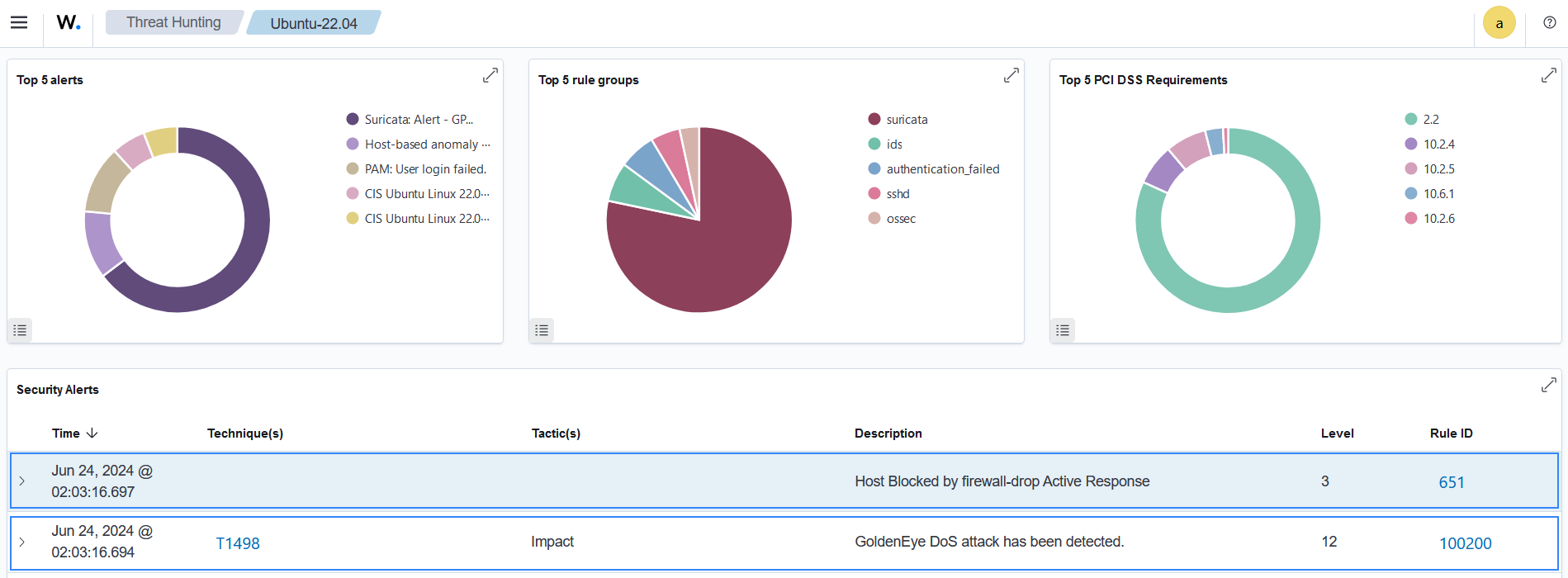
Wazuh blocks a DoS attack against a monitored Ubuntu endpoint.
Vulnerability assessment
Wazuh performs regular scans for vulnerabilities to ensure that systems are up-to-date and less susceptible to threats that can potentially cause system failure. The Wazuh vulnerability detection capability lets you discover security flaws and exploitable threats on endpoints and applications. This information is based on the vulnerabilities repository in the Wazuh Cyber Threat Intelligence (CTI) platform which aggregates CVE feeds retrieved from external vulnerability sources. These sources include Canonical, Debian, Red Hat, Arch Linux, Amazon Linux Advisories Security (ALAS), Microsoft, and the National Vulnerability Database (NVD).
The Wazuh vulnerability detection capability helps you to minimize the risks of attacks to maintain system and service availability. You can see a summary of all the vulnerable packages installed on a monitored endpoint by clicking Vulnerability Detection on the Wazuh dashboard and selecting the agent.
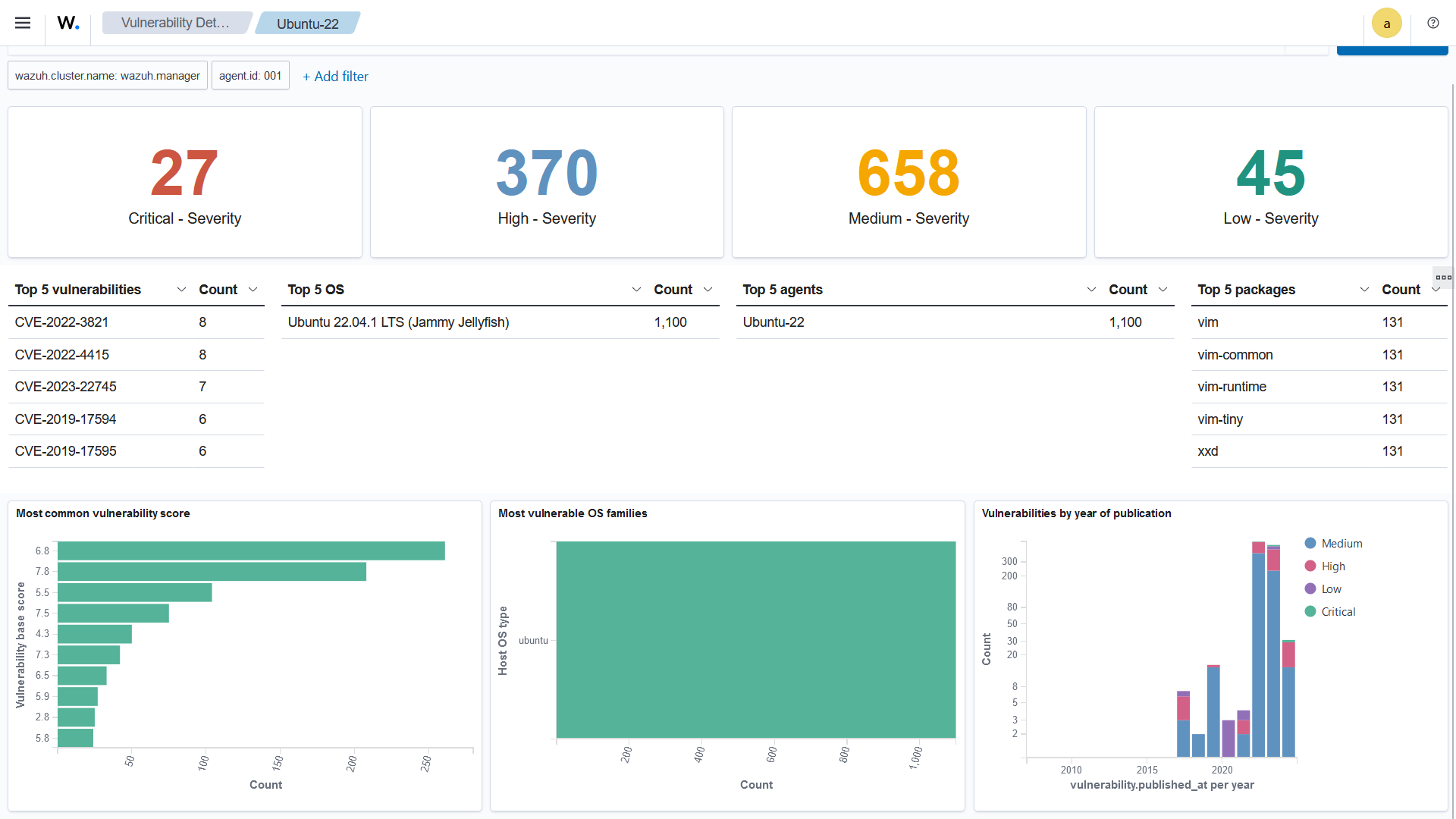
Summary of vulnerable packages discovered on a monitored Ubuntu endpoint.
Additionally, you can see the inventory of all the vulnerable packages installed on an endpoint by selecting the Inventory tab on the Wazuh dashboard.
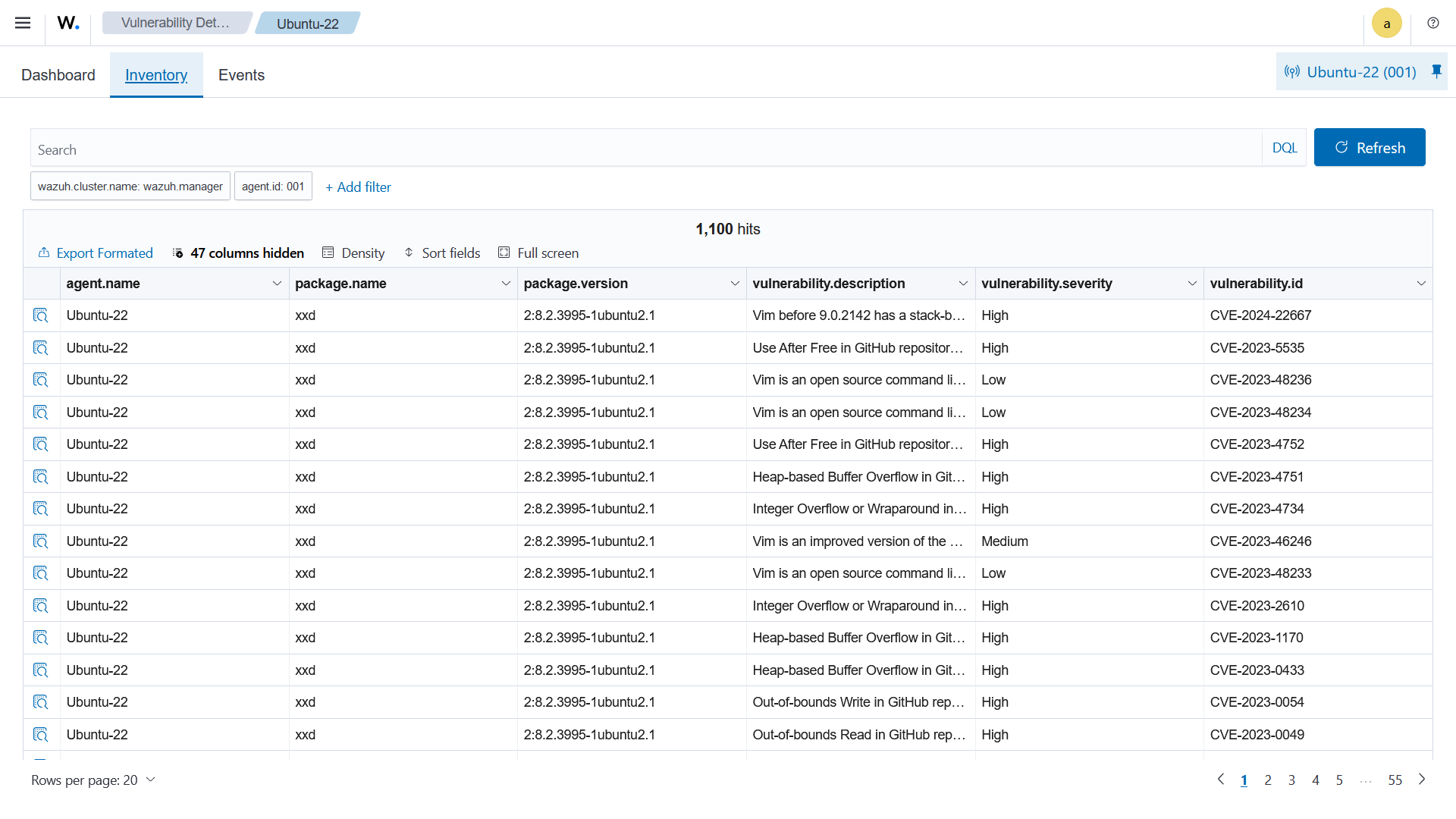
Inventory of vulnerable packages discovered on the monitored Ubuntu endpoint.
Key takeaway
Ensuring the confidentiality, integrity, and availability of information and critical assets from unauthorized access, use, disruption, modification, or destruction forms the pillars of information security. This foundation is indispensable to the security of your organization's posture.
Wazuh is a comprehensive XDR and SIEM security monitoring platform that aligns with the CIA triad, addressing each principle through its many capabilities. Implementing Wazuh contributes to maintaining the confidentiality, integrity, and availability of your critical systems and data. For more information on how Wazuh ensures information security, check out its documentation to learn about its various capabilities.
References
NEVER MISS THE NEWS THAT MATTERS MOST
ZEROHEDGE DIRECTLY TO YOUR INBOX
Receive a daily recap featuring a curated list of must-read stories.

